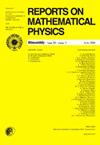Density Operator Formulation for a Supersymmetric Harmonic Oscillator: Vector Coherent State Construction and Statistical Properties
IF 1
4区 物理与天体物理
Q3 PHYSICS, MATHEMATICAL
引用次数: 1
Abstract
Motivated by our recent work published in [23], we achieve, in this paper, a matrix formulation of the density operator to construct a two-component vector coherent state representation for a supersymmetric harmonic oscillator. We investigate and discuss the main relevant statistical properties. We use the completeness relation to perform the thermodynamic analysis in the diagonal P-representation of the density operator.
超对称谐振子的密度算子公式:矢量相干态构造和统计性质
受我们最近在[23]上发表的工作的启发,我们在本文中实现了密度算子的矩阵公式,用于构造超对称谐振子的双分量矢量相干态表示。我们调查和讨论了主要的相关统计性质。我们使用完备关系在密度算子的对角p表示中进行热力学分析。
本文章由计算机程序翻译,如有差异,请以英文原文为准。
求助全文
约1分钟内获得全文
求助全文
来源期刊

Reports on Mathematical Physics
物理-物理:数学物理
CiteScore
1.80
自引率
0.00%
发文量
40
审稿时长
6 months
期刊介绍:
Reports on Mathematical Physics publish papers in theoretical physics which present a rigorous mathematical approach to problems of quantum and classical mechanics and field theories, relativity and gravitation, statistical physics, thermodynamics, mathematical foundations of physical theories, etc. Preferred are papers using modern methods of functional analysis, probability theory, differential geometry, algebra and mathematical logic. Papers without direct connection with physics will not be accepted. Manuscripts should be concise, but possibly complete in presentation and discussion, to be comprehensible not only for mathematicians, but also for mathematically oriented theoretical physicists. All papers should describe original work and be written in English.
 求助内容:
求助内容: 应助结果提醒方式:
应助结果提醒方式:


